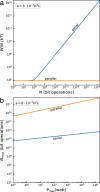Fundamental energy cost of finite-time parallelizable computing
- PMID: 36707510
- PMCID: PMC9883481
- DOI: 10.1038/s41467-023-36020-2
Fundamental energy cost of finite-time parallelizable computing
Abstract
The fundamental energy cost of irreversible computing is given by the Landauer bound of [Formula: see text]/bit, where k is the Boltzmann constant and T is the temperature in Kelvin. However, this limit is only achievable for infinite-time processes. We here determine the fundamental energy cost of finite-time parallelizable computing within the framework of nonequilibrium thermodynamics. We apply these results to quantify the energetic advantage of parallel computing over serial computing. We find that the energy cost per operation of a parallel computer can be kept close to the Landauer limit even for large problem sizes, whereas that of a serial computer fundamentally diverges. We analyze, in particular, the effects of different degrees of parallelization and amounts of overhead, as well as the influence of non-ideal electronic hardware. We further discuss their implications in the context of current technology. Our findings provide a physical basis for the design of energy-efficient computers.
© 2023. The Author(s).
Conflict of interest statement
The authors declare no competing interests.
Figures




References
-
- Moore GE. Cramming more components onto integrated circuits. Electronics. 1965;38:114–117.
-
- Theis TN, Wong HSP. The End of Moore’s law: A new beginning for information technology. Comput. Sci. Eng. 2017;19:41–50.
-
- Waldrop MM. The chips are down for Moore’s law. Nature. 2016;530:144–147. - PubMed
-
- Arden, W. et al. “More-than-Moore” White Paper, International Roadmap for Devices and Systems (IRDS) (2015).
-
- Landauer R. Irreversibility and heat generation in the computing process. IBM J. Res. Dev. 1961;5:183–191.
Grants and funding
LinkOut - more resources
Full Text Sources

